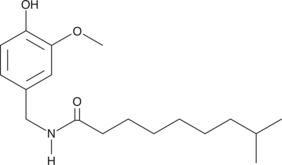Description
A terpene alkaloid; active against a variety of bacteria and C. albicans (MICs = 0.6-10 µg/ml); scavenges DPPH and ABTS radicals in cell-free assays; increases LC3-II and catalase levels and reduces ROS production in normal WI38 lung fibroblasts and H1299, but not A549 or H460, lung cancer cells at 200 µM; induces cortical and systemic hypothermia and reduces infarct volume in a rat model of ischemia-reperfusion injury induced by MCAO at 0.5 mg/kg
Formal name: N-[(4-hydroxy-3-methoxyphenyl)methyl]-8-methyl-nonanamide
Synonyms:
Molecular weight: 307.4
CAS: 19408-84-5
Purity: ≥98%
Formulation: A crystalline solid



